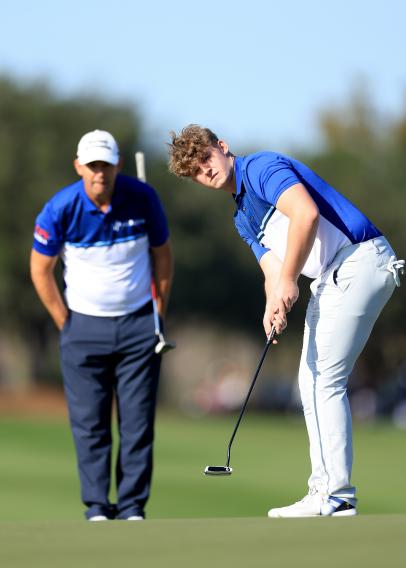This article first appeared in Low Net, a weekly newsletter written for the average golfer, by an average golfer. To get Low Net each week, sign up for Golf Digest+.
Have a topic you want me to explore? Send me an email and I’ll do my best to dive in.
A few years ago, Golf Digest’s net stroke-play tournament featured a unique twist. Rather than have everyone play from the same set of tees, players could choose the tees they wanted, and their allotment of strokes would be adjusted accordingly. The further back you went, the more strokes you got. Move up, and you got fewer.
The broad selection of tee boxes proved a sort of Rorschach test on golfers’ mindsets. Some staffers played the standard tees, while a few boldly went all the way back to 7,100 yards and grabbed a fistful of additional strokes. I went in the opposite direction. In moving up, I was electing for fewer strokes, but figured it’d be fun, and scoring would be easier.
Turns out we were only partially right. I finished near the bottom of the pack.
That day, and in ensuing experiments playing shorter yardage, the consistent takeaway has been that moving up tees is a welcome change of pace. But it doesn’t always make the game easier. If anything, it challenges you to be better in ways you probably overlook.
“It’s probably the best thing you can do when learning how to score,” recent U.S. Open champion Bryson DeChambeau said last year.
First, the obvious: Shorter yardage means less club into greens, which means a better chance of hitting greens in regulation, and more birdie looks as a result. Why would this be complicated? Because nothing in golf is that easy.
More Low Net Golf Digest Logo How to be a less miserable golfer  Low Net The best case for golf yet
Low Net The best case for golf yet  Golf Digest Logo A Hall of Famer’s valuable advice for teaching your kids golf
Golf Digest Logo A Hall of Famer’s valuable advice for teaching your kids golf
A longer explanation can be best summarized through an experience I’ve chronicled before, when I played an 18-hole round with the PGA Tour pro Joel Dahmen in which I hit Joel’s drives and he hit mine. That day featured all the benefits you’d expect when a tour pro was teeing off from the members’ tees, like when Dahmen left me with a half-wedge into the first green, which I stuck to a foot for an opening birdie.

Netflix
But that round also underscored what DeChambeau and others are referring to when they say shorter yardage is so important for learning how to score. Every time I play forward tees, my perspective on a golf hole shifts. Unlike with a longer club in which I factor in the broad range of potential outcomes, a shorter club narrows my target to the point that I occasionally make devastating mistakes. On the second hole in my round with Dahmen, I took on a tucked pin with my pitching wedge, airmailed the green into a back bunker and made a mess from there.
“I think everyone should be hitting only to the middle of the green unless inside of 50 yards,” said Jeff Ritter, a Golf Digest Best Teacher in Oregon. “Playing more forward, I would think would make it more difficult for players to adhere to this strategy model.”
In short, the “easier” a hole plays, the less attention paid to your limitations, leading to outsized risk. Although magnified in shorter-yardage experiments, this is an everyday problem for most of us. This season three Golf Digest colleagues and I are chronicling the progress of our games and our Handicap Index for an ongoing project, yet my season so far is disjointed. My game feels better than ever, so why have my scores stayed basically the same?
The answer lies in the same tendencies displayed in my round with Dahmen or at that company tournament. Whether because of improved ball-striking or because of forward tees, higher expectations over a shot increase the likelihood of you trying something dumb. It’s why it helps to manufacture those situations to better understand when you can afford to be aggressive and when you can’t.
The irony of playing up on occasion is it’s not likely to immediately lower your handicap index since course ratings from forward tees are generally lower. But if it’s teaching you how to score, the progress will be apparent before long.
This article was originally published on golfdigest.com

